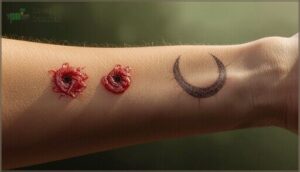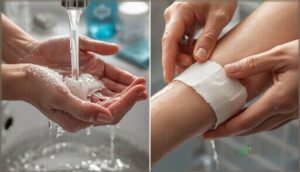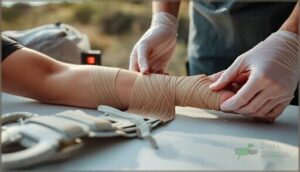This site is supported by our readers. We may earn a commission, at no cost to you, if you purchase through links.
 A snake bite delivers venom in seconds, but your response in the first few minutes can mean the difference between a full recovery and serious complications. Most people panic or reach for folk remedies that do more harm than good.
A snake bite delivers venom in seconds, but your response in the first few minutes can mean the difference between a full recovery and serious complications. Most people panic or reach for folk remedies that do more harm than good.
The truth is that proper snake bite first aid isn’t complicated, but it goes against many common instincts. You don’t need to identify the snake species or try to capture it. You don’t need ice, tourniquets, or a knife.
What you need is a clear action plan that keeps venom from spreading while you get to medical care. The steps are straightforward, and knowing them before you need them can save your life or someone else’s.
Table Of Contents
- Key Takeaways
- What to Do Immediately After a Snake Bite
- How to Identify a Venomous Snake Bite
- First Aid Steps for Snake Bites
- Medical Treatment and Complications
- Preventing Snake Bites and Reducing Risk
- Frequently Asked Questions (FAQs)
- What does a snake bite look like?
- How many people die from snake bites each year?
- What is the most dangerous snake?
- Can children survive snake bites as easily as adults?
- How long does snake venom stay in your body?
- Are snake bites more dangerous at certain times of year?
- Can you build immunity to snake venom over time?
- Do all hospitals stock antivenom for local snakes?
- Conclusion
Key Takeaways
- The first few minutes after a snake bite determine recovery outcomes—immediately move 20-30 feet from the snake, stay calm to slow venom spread, call 911, and keep the bitten limb still at heart level while removing jewelry before swelling traps it.
- Skip dangerous myths like tourniquets, cutting the wound, ice, or suction devices—instead, clean the bite with soap and water, apply a loose dressing, and use firm elastic bandaging with a splint to slow venom through the lymphatic system.
- Venomous bites show two puncture marks with rapid swelling and burning pain within 15 minutes, while 20-60% of bites are “dry” with no venom injection, but all snake bites require 12-24 hours of hospital monitoring to catch delayed complications.
- Antivenom works best within three hours and prevents permanent damage, but hospital care extends beyond that—you’ll need continuous monitoring, supportive treatment for bleeding or shock, and follow-up visits within 2-3 days to catch infections or serum sickness.
What to Do Immediately After a Snake Bite
A snake bite can feel like everything happens at once, but your first few minutes matter most. What you do right after the bite can slow venom spread and buy you critical time until help arrives.
Here’s what you need to do immediately to protect yourself and improve your chances of a full recovery.
Move Away From The Snake Safely
The moment a snake bites, back away at least 20 to 30 feet to stop the snake from striking again. Most second bites happen when you stay too close. Choose open ground over tall grass or brush where another snake might hide. Never try to catch or kill it—even dead snakes can bite reflexively for up to an hour.
Your first move sets the tone for everything that follows. Remember to check for two puncture marks at the bite site.
Stay Calm and Limit Movement
Once you’re safely away, fight the urge to panic. Panic effects hit fast—your heart rate spikes and blood pressure climbs, which speeds venom spread through your body.
Keep the bitten limb still. Movement pushes venom into your bloodstream faster. Immobilizing the affected area can delay severe symptoms for hours, buying you time for medical help and improving recovery outcomes considerably.
Remember that snakebite fatality rates are actually quite low.
Call Emergency Services (911)
Pick up your phone and dial 911 immediately. Don’t drive yourself—emergency medical services bring trained paramedics, ambulance equipment including antivenom, and rapid transport to equipped hospitals. Dispatcher protocols guide you through next steps while poison control coordinates your care. Studies show 85% of victims who call emergency help within the first hour see dramatically better outcomes. Minimize delays, improve survival.
Call 911 immediately after a snake bite—emergency services bring antivenom, trained paramedics, and rapid hospital transport that dramatically improve survival
- Tell the dispatcher exactly where you’re
- Describe the snake if possible
- Report symptoms developing in real time
Remove Jewelry and Tight Items
While help is on the way, slip off rings, watches, and bracelets from the bitten limb. Venom triggers rapid swelling—sometimes 15 to 30% within two hours—and constricting items can act like unintentional tourniquets. This increases ischemia risk and tissue damage.
Removing jewelry early prevents circulation problems and helps with effective bandage application. It’s a simple step with serious protective power in snakebite first aid protocols.
Position The Bite Below Heart Level
Keep the bitten limb still and at heart level—not below it. Positioning the bite lower increases hydrostatic pressure and limb pressure, which worsens tissue damage and raises necrosis risk. Some field studies show a 40–70 mm increase in pressure when limbs hang down, elevating compartment syndrome danger.
This first aid measure for snake bites slows venom spread while protecting local tissue before help arrives.
How to Identify a Venomous Snake Bite
You can’t always tell if a snake is venomous just by looking at it after a bite happens. The real clues show up in what your body does next and what marks appear on your skin.
Here’s what separates a venomous bite from a harmless one.
Recognizing Bite Marks and Local Symptoms
Most snake bites leave a clear signature. Look for two distinct puncture wounds—fang marks—which appear in about 72% of venomous bites. You’ll usually see them on your lower leg or foot.
Watch for rapid swelling that starts within 15 minutes and expands dramatically. Immediate burning pain, redness around the bite wound, and developing bruises signal venom injection and demand urgent medical attention.
Common Signs of Envenomation
Venom triggers a predictable cascade of effects that your body can’t hide. Watch for these symptoms of snake envenomation that signal danger:
- Local Pain intensifies rapidly at the bite site, spreading outward with burning sensations
- Systemic Effects like nausea, vomiting, and weakness affect 37-62% of victims
- Neurological Signs include drooping eyelids, tingling fingers, and breathing difficulty
- Coagulation Issues cause abnormal bleeding and bruising in up to 44% of cases
- Cardiovascular Impact manifests as racing heart, low blood pressure, or shock
Types of Venomous Snakes in Your Area
Your region determines which venomous snakes pose the greatest threat. Rattlesnakes account for nearly 80% of fatal snakebites and inhabit every contiguous state except Maine.
Copperheads dominate eastern woodlands and cause over a third of pit viper bites annually.
Cottonmouths patrol southeastern wetlands with tissue-destroying venom.
Coral snakes deliver neurotoxic venom in spring but cause fewer than 2% of envenomations.
Dry Bites Vs. Venomous Bites
Not every snakebite injects venom. Between 20% and 60% of snakebites worldwide are dry bites—you’ll feel pain but see minimal swelling. Venomous bites trigger rapid symptom onset with severe swelling, bleeding, or breathing trouble within 30 minutes.
Clinical observation for 12 hours confirms bite severity and antivenom necessity. Watch for progression. Mild initial symptoms don’t rule out long-term effects or delayed envenomation.
First Aid Steps for Snake Bites
After you’ve called for help and positioned the bite correctly, the next steps matter just as much. Proper wound care and smart decision-making can prevent complications while you wait for medical treatment.
Here’s what you need to do—and what dangerous myths you should ignore.
Cleaning and Covering The Wound
After calling for help, gently wash the bite with soap and clean water. This simple act reduces infection risk without causing further harm. Pat it dry, then apply a loose, clean dressing.
Your wound care checklist:
- Use mild soap and water, not alcohol or peroxide
- Cover with sterile gauze or a clean cloth
- Keep the bandage loose to allow blood flow
- Change the dressing if it becomes soiled
- Watch for increasing redness or warmth
Immobilizing The Affected Area
Once the wound is clean and covered, keep the bitten extremity still. Wrap a firm elastic bandage from fingers or toes upward, matching the pressure you’d use for a sprained ankle. Add a splint to prevent movement.
This pressure immobilization bandaging slows venom spread through your lymphatic system, buying critical time before medical help arrives—even in remote settings.
What NOT to Do (first Aid Myths)
You’ve done the right things—now don’t undo your progress with outdated myths.
Don’t apply a tourniquet; it risks limb gangrene and tissue death. Never cut the wound or attempt venom removal with suction devices like the Sawyer Extractor—these methods fail and worsen bleeding.
Skip ice packs; they increase tissue damage. Avoid electric shock and folk remedies.
These snakebite first aid myths delay proper care and harm outcomes.
Monitoring for Severe Symptoms
Keep watching for signs that venom has spread beyond the bite. Key sign changes like rapid pulse or dropping blood pressure signal trouble.
Neurological decline—drooping eyelids, slurred speech, or breathing difficulties—means respiratory failure may follow.
Watch for severe pain and swelling that climbs up the limb. Coagulation issues show as bleeding gums or bruising.
Renal complications and worsening symptoms of envenomation demand immediate medical escalation.
Medical Treatment and Complications
Once you reach the hospital, doctors will assess the bite and determine whether you need antivenom. Treatment goes beyond just neutralizing venom—it involves managing complications that can threaten your life or long-term health.
Here’s what to expect during medical care and recovery.
When and How Antivenom is Given
Antivenom therapy works best within three hours of a venomous bite—this “golden window” can stop neurotoxicity and muscle damage before they take hold.
Doctors give it through an IV over 30 to 45 minutes, watching you closely since reactions occur in about one in five patients.
If systemic symptoms like breathing trouble or collapse appear, antivenom administration starts immediately without waiting for lab results.
Potential Complications (bleeding, Shock, Tissue Damage)
Venom triggers dangerous systemic bleeding in nearly one in four bite victims—watch for blood in urine, vomit, or wounds that won’t clot. Shock develops in about five percent of cases when blood pressure drops suddenly.
Tissue necrosis destroys muscle and skin within 24 hours, sometimes requiring amputation if untreated.
Kidney damage and organ failure represent serious long-term threats from snakebite complications.
Hospital Monitoring and Supportive Care
Once you arrive at the hospital, expect continuous medical treatment that includes important signage checks every one to two hours and supportive care measures designed to prevent complications. Your healthcare team monitors you for 24 to 48 hours minimum, watching for delayed symptoms.
Standard hospital protocols include:
- IV fluid resuscitation to stabilize blood pressure and maintain hydration
- Wound management with sterile dressings and infection prevention
- Antiemetic usage and pain relief to control nausea and discomfort
- Transfusion support if bleeding develops or coagulation becomes abnormal
Blood tests repeat every six hours initially, tracking kidney function and clotting ability while medical assistance stands ready for emergencies.
Follow-up Care and Recovery
After discharge, you’ll need a follow-up visit within two to three days to check for delayed complications like wound infection or serum sickness. Your doctor monitors long-term effects through blood work and wound assessments, while physical therapy helps restore function. Don’t overlook mental health—many survivors experience stress symptoms requiring professional support during recovery.
| Timeline | Medical Focus | Watch For |
|---|---|---|
| 2–3 days | Wound infection signs | Redness, fever, drainage |
| 2 weeks | Serum sickness screening | Rash, joint pain, fever |
| 2–6 weeks | Physical therapy assessment | Stiffness, limited movement |
| 6 months | Long-term effects review | Persistent pain, weakness |
| Ongoing | Mental health support | Anxiety, depression, PTSD |
Preventing Snake Bites and Reducing Risk
The best defense against a snake bite is never getting bitten in the first place. Most bites happen when people accidentally step on snakes or get too close to their hiding spots.
Here’s how you can greatly reduce your risk before you ever encounter a snake.
Wearing Protective Clothing Outdoors
Simple clothing can cut venom injection by about two-thirds. That’s why protective gear matters when you’re heading outdoors in snake country. Your first aid kit should include proper clothing too:
- Boots and long pants – Cover ankles and lower legs where most bites occur
- Leather gloves – Protect hands during yard work or trail clearing
- Gaiters – Add extra coverage below the knee for high-risk areas
This protective clothing reduces bite severity and lowers treatment costs.
Avoiding Snake Habitats and Provocation
Most snakes won’t bite unless provoked. Avoid provocation by giving snakes space to retreat when you spot them. Outdoor awareness saves lives—watch where you step and sit.
Clear stacked firewood and debris away from your home to reduce encounters. Habitat modification like maintaining drainage and trimming vegetation keeps snakes at a distance.
Respect wildlife and never attempt to handle or kill snakes. Understanding local snake species improves your risk reduction strategy.
Preparing for Emergencies in Snake-prone Areas
Emergency preparedness in snake-prone areas requires you to plan ahead. Know the number for the Poison Control Center’s National Hotline and keep a first aid kit stocked with supplies for snakebite emergencies.
Antivenom access may be limited in rural regions, so identify the nearest hospital that stocks it.
Community education and infrastructure readiness strengthen risk reduction, ensuring you’re protected before trouble strikes.
Raising Awareness of Local Snake Species
Beyond having your first aid kit ready, knowing your local snake species strengthens your safety net. Snake ID skills reduce misconceptions and fear that lead people to panic or harm harmless snakes.
Community education programs boost coexistence strategies and species conservation efforts. When you understand which snakes pose real danger, you make smarter decisions outdoors.
- Learn to identify venomous versus non-venomous snakes in your region
- Attend local snake awareness events or workshops
- Share snake bite prevention knowledge with neighbors and family
- Support conservation efforts that protect beneficial snake populations
Frequently Asked Questions (FAQs)
What does a snake bite look like?
Look for two deep puncture marks with swelling. Non-venomous bites show shallow scratches. Redness spreads fast. Blisters and small purple spots signal serious venom. Tissue damage worsens without treatment.
How many people die from snake bites each year?
You’ll face the harsh reality: around 81,000 to 138,000 people die from snakebites each year worldwide. That’s a global mortality rate driven by regional death tolls, particularly in vulnerable populations across Asia and Africa.
What is the most dangerous snake?
There isn’t one deadliest snake. The inland taipan has the most potent venom, but saw-scaled vipers and Russell’s vipers cause the most deaths due to high bite incidence and limited antivenom.
Can children survive snake bites as easily as adults?
Children face higher risks from snake bites due to their smaller size and faster venom spread. Pediatric mortality rates are lower than adults at 9%, but severe complications like tissue damage and respiratory failure require immediate first aid treatment.
How long does snake venom stay in your body?
Snake venom generally clears from your body within 24 hours through kidney elimination. However, venom half-life ranges from 4 to 24 hours, and detection windows extend 24 to 72 hours depending on influencing factors like clearance pathways.
Are snake bites more dangerous at certain times of year?
Yes, snake bites are more dangerous during peak activity months from April to October in temperate regions, and during rainy season in tropical areas, when juvenile snake risk increases alongside seasonal venom potency.
Can you build immunity to snake venom over time?
Building acquired resistance to snake venom through repeated exposure can trigger antibody production, but self-immunization risks are severe—including death.
Venom variability and toxins make immunity unpredictable.
Historical mithridatism proves dangerous, not protective.
Do all hospitals stock antivenom for local snakes?
In remote Montana, a hiker reached the nearest hospital only to learn their antivenom had expired months ago.
Most hospitals don’t stock antivenom due to high costs and short shelf life, especially in low-incidence areas.
Conclusion
Staying steady and systematic makes all the difference. When you know what to do when snake bites strike, you replace panic with purposeful action. The steps are simple: distance yourself from danger, stay still, call for help, and keep the bite immobilized below your heart.
Skip the myths and trust the protocol. Every second you follow these guidelines protects tissue and buys time for antivenom. That clarity under pressure doesn’t just help—it saves lives.
- https://www.who.int/news-room/events/detail/2025/09/19/default-calendar/international-snakebite-awareness-day-2025--isbad-25
- https://journals.plos.org/plosntds/article?id=10.1371%2Fjournal.pntd.0012080
- https://jogh.org/2025/jogh-15-04062/
- https://pmc.ncbi.nlm.nih.gov/articles/PMC12333078/
- https://hr.un.org/sites/hr.un.org/files/ID_SnakeBite_SOP_2024-01.pdf













